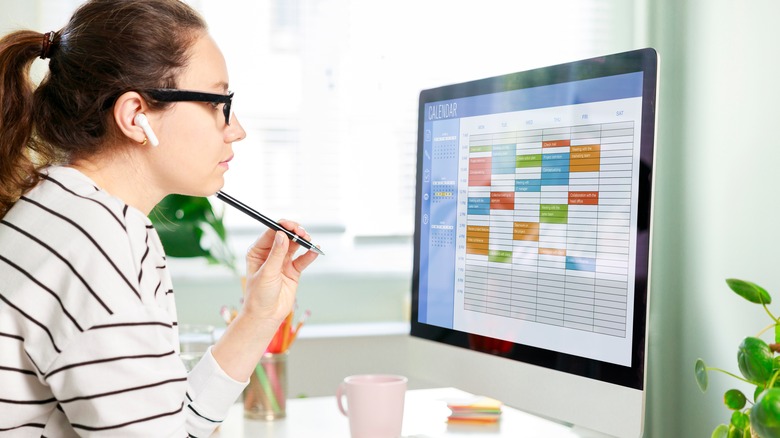The Scheduling Tip That Will Help You With Work-Life Balance If You WFH
Since the pandemic began, working from home became many of our new normals. But beyond the convenience of your home coffee maker, wearing sweats, and no commute, WFH also presented new challenges. Staying on task might feel harder when your streaming channels are easily accessible. Keeping to a routine is difficult when you don't have coworkers around you following a similar schedule. And it may be tempting to keep working on projects at night and on the weekends when it feels necessary.
However, in order to maintain boundaries between our home life and work life, working from home requires coming up with a new set of rules for the workday, starting with your morning routine and prioritizing consistency over convenience. Some techniques to stay motivated and focused during your WFH day may look like they would in the office: asking for performance feedback to keep striving for growth, or scheduling brainstorming sessions to connect with your colleagues. But even with the apps and tech that make WFH possible pretty much anywhere (with Wi-Fi), breaks are still important, and it's vital to create boundaries around your time and energy so that your life and work remain in balance.
Start your day right
When you wake up at home, your 9 am meeting may feel like a great excuse to sleep in until 8:55 am. But starting our day with a meeting first thing can take a toll on the separation between work and our personal lives. Instead, it may be helpful to wake up with enough buffer time to fit in a sweet morning ritual, like reading your new book over a cup of coffee or cooking your favorite breakfast.
If you're someone who works best when you've let some energy out, scheduling a morning yoga session may be the perfect way to start your day. Setting aside time to listen to music or get excited for your day can also help you shake off any baggage and have a fresh and energizing start. It's also good to set aside time for midday breaks. Hanako Maeda, Founder and CEO of Adeam, told Harpers' Bazaar, "While working from home, it's been helpful to set alarms to indicate office hours and also give myself breaks for 12 p.m. lunchtime and 3 p.m. coffee breaks." She explained, "It helps me to have breaks once in 3 to 4 hours to keep my productivity."
Aurora James, Creative Director of Brother Vellies, also told Harpers' Bazaar about her routine, "Maintaining a schedule helps me bring structure — a Pilates zoom class at 9 a.m., lunch at 1 p.m., etc." Still, besides a lack of structure, our homes provide other workday obstacles.
Plan your chores around your day
Just like keeping your WFH and rest spaces separate, it's good to remember that messy environments in either sphere may have an effect on your productivity and anxiety levels throughout the week. Per The Harvard Business Review, a cluttered desk may lead to procrastination, as well as avoidance. A pile of notes may make starting a new day come with a bit of an organization hangover — so set time aside at the end of your previous work day to tidy up for your future self.
Dirty dishes sitting in the sink or a messy kitchen may also become a distraction during your lunch break and have you spending unaccounted for time cleaning up. So plan on cleaning up the night before to have a clean WFH slate without constant reminders of undone chores.
Ultimately, you should make as many decisions as possible in advance so that your day isn't spent spiraling about what you're going to eat for lunch or when you'll walk the dog. Of course, it can be hard to predict how we'll feel on a given day. But if we set aside certain blocks of time for similar tasks — in the vein of a Time-Block Planner — we can deal avoid distractions or new tasks and come back to them during their allotted time. If you find time is still getting away from you, try setting labeled alarms to help you stay on task.


